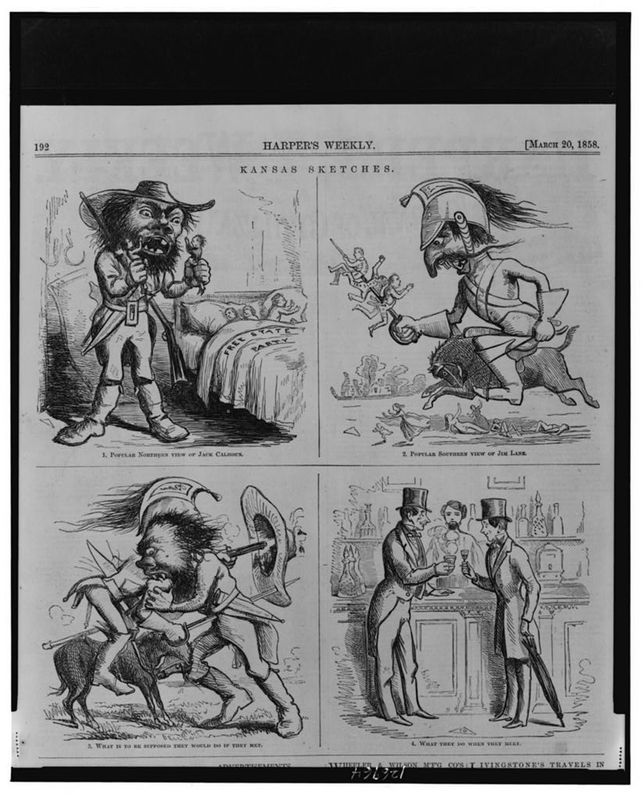"Kansas Affairs"
By Matthew Mosher
Proslavery and Free State forces squared off over the Kansas territory after the passage of the Kansas-Nebraska Act (1854). The “Bleeding Kansas” period (1854-1859) set the tone for the unraveling of American society as abolitionists and slaveholders squared off in the territories, along slave/free Border States, and in the halls of Congress. A cartoon from the March 20, 1858 edition of Harper's Weekly depicts these conflicts. Earlier editions of the periodical indicate the readership closely followed “Kansas Affairs.”[1] At the beginning of 1858, one of the primary issues in Kansas revolved around split government. Pro-slavery and Free State forces each elected their own state government and drafted their own state constitutions. How the territory and the nation would respond remained the unanswered question.[2]
Bleeding Kansas put Free Soil and pro-slavery forces at odds. Pro-slavery representatives, seizing power in an arguably fraudulent election, because “the bulk of the people of Kansas abstained from the election,”[3] enacted a Kansas state constitution. In language, suggesting the paper leaned toward abolitionists, the Harper's Weekly January 1858 issue described “monstrous” frauds committed by politicians “bent on keeping the Kansas quarrel alive.”[4] Later reports seem to confirm these claims stating, “Abolitionists in Kansas have thus far sought power by methods unknown to the law and by acts of violence.”[5] The cartoon depicting Calhoun and Lane supports the argument that “armed vigilantes held sway in many counties, physically intimidating anyone who voiced antislavery opinions,”[6] as a means of keeping pro-slavery forces in power.
Pro-slavery adherents also used underhanded political ploys in attempts to remain in power. John Calhoun sent a statement to the House Kansas Investigating Committee, which claimed that the results of voting in Kansas gave pro-slavery a “nominal” majority but “it was decided that it should not be considered evidence.”[7] This indicates Congress understood the lengths pro-slavery forces took in Kansas to ensure their hold on power.
Proslavery violence and intimidation tactics failed because Free Soil advocates formed their own government and chartered their own state constitution.[8] This is not to say Free Soilers did not fight back. The cartoon pictures James Lane who led Free Soilers into battle and “matched the rebel bushwhackers in freebooting tactics.”[9] “Political direction was furnished by James Lane”[10] who “recognized in the Free Soil movement a chance to rejuvenate his political career.”[11]
The cartoon I analyzed portrays the militancy of both pro- and anti-slavery advocates and the increasing turn to violence as a political solution as the 1850s ended. In 1858, “Jayhawkers and border ruffians raided and ambushed each other with considerable ferocity.”[12] The escalating political and military situation in Kansas drew the attention of national politicians and citizens alike. Harper's Weekly reflected this national attention by publishing articles on Kansas at least once per month, often more, for the entire year of 1848.
This political cartoon, published by Harper's Weekly, depicts John Calhoun and James Lane. The cartoon depicts the “Popular Northern View” of Calhoun, an avid proslavery activist and leader of forces along the Missouri-Kansas border; he viciously snatches Free State Party members from their beds and consumes them in the night. This might symbolize the peaceful intentions of Freestaters compared to the militancy of proslavery activists like Calhoun. The “Popular Southern View” of James Lane shows him trampling women and children with his horse while skewering the southern men on his sword. The imagery implies that Lane tramples on the rights of helpless free southerners.
The third block portrays the popular concept of the results of an actual meeting between Lane and Calhoun. Each antagonist has skewered the other. Calhoun uses a weapon resembling a Bowie knife, a weapon linked to frontiersmen and westward expansion. Lane uses a saber, sits astride a horse, and wears the uniform of a cavalry officer. The two portrayals seem to pit the slaveholding expansionists against the federal government. The fourth block reveals “What They Do When They Meet,” depicting both men dressed genteelly, toasting each other in an amicable setting. While each man attempted to gather forces to their cause, and perpetrated or responded to violence in the Bleeding Kansas period the cartoon demonstrates men of rank and wealth in America behaved in a certain manner towards one another, despite political differences.
Endnotes:
[1] “Domestic Intelligence: Kansas Affairs,” Harper’s Weekly, February 20, 1858, accessed February 5, 2015, http://app.harpweek.com.prox.lib.ncsu.edu/viewarticletext.asp?webhitsfile=hw18580220000030.htm&xpath=%2FTEI.2%5B1%5D%2Ftext%5B1%5D%2Fbody%5B1%5D%2Fdiv1%5B16%5D&xml=HW\1858\18580220.xml&titleid=HW&volumeid=1858&issueid=0220&pagerange=0118bd-0118bd&restriction=lane+AND+calhoun+&pageIds=|HW-1858-02-20-0118.
[2], Celia, A Slave (Athens: University of Georgia Press, 1991), 62-79.
[3] Harper’s Weekly, January 9, 1858, accessed February 5, 2015, http://app.harpweek.com.prox.lib.ncsu.edu/viewarticletext.asp?webhitsfile=hw18580109000034.htm&xpath=%2FTEI.2%5B1%5D%2Ftext%5B1%5D%2Fbody%5B1%5D%2Fdiv1%5B8%5D&xml=HW\1858\18580109.xml&titleid=HW&volumeid=1858&issueid=0109&pagerange=0018c-0018c&restriction=kansas+&pageIds=|HW-1858-01-09-0018|
[4] Harper’s Weekly, January 9, 1858.
[5] Harper’s Weekly, February 27, 1858, accessed February 5, 2015, http://app.harpweek.com.prox.lib.ncsu.edu/viewarticletext.asp?webhitsfile=hw18580227000031.htm&xpath=%2FTEI.2%5B1%5D%2Ftext%5B1%5D%2Fbody%5B1%5D%2Fdiv1%5B16%5D&xml=HW\1858\18580227.xml&titleid=HW&volumeid=1858&issueid=0227&pagerange=0134bd-0135a&restriction=lane+AND+calhoun+&pageIds=|HW-1858-02-27-0134|HW-1858-02-27-0135|
[6] McLaurin, Celia, A Slave, 78.
[7] “Domestic Intelligence: Political: Congress,” Harper’s Weekly, March 13, 1858, accessed February 5, 1858, http://app.harpweek.com.prox.lib.ncsu.edu/viewarticletext.asp?webhitsfile=hw18580313000029.htm&xpath=%2FTEI.2%5B1%5D%2Ftext%5B1%5D%2Fbody%5B1%5D%2Fdiv1%5B15%5D&xml=HW\1858\18580313.xml&titleid=HW&volumeid=1858&issueid=0313&pagerange=0166ad-0166ad&restriction=kansas+~+calhoun+&pageIds=|HW-1858-03-13-0166|
[8] McLaurin, Celia, A Slave, 75-76.
[9] James McPherson, Battle Cry of Freedom (New York: Oxford University Press, 1988), 292.
[10] McLaurin, Celia, A Slave, 76.
[11] McLaurin, Celia, A Slave, 76.
[12] McPherson, Battle Cry of Freedom, 169.
